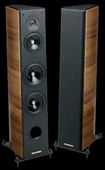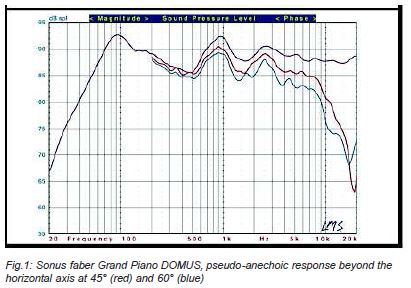Dear All,
Does anybody have the schematic of the x-over of the Grand Piano Domus ?
They do not have the post for bi-amping and I was trying to understand if this would be possible isolating sections of the x-over.
Thanks,
Davide
Does anybody have the schematic of the x-over of the Grand Piano Domus ?
They do not have the post for bi-amping and I was trying to understand if this would be possible isolating sections of the x-over.
Thanks,
Davide
It has to be possible. I presume you have the speakers at your disposal
to do whatever you want? Take the crossover board out and post a photo
from both of the sides with markings which wires go where.
to do whatever you want? Take the crossover board out and post a photo
from both of the sides with markings which wires go where.
From looking at the review measurements, that speaker needs more than just biamping. 🙂 You should be prepared to do a full analysis of the speaker and either remake the crossover, particularly the mid to tweeter portions, or correct for it in DSP.
Having said that, you can always add your own cable connectors and wire them to the drivers directly, bypassing the existing crossovers completely. I suspect once you open it up you won't find much you'll want to keep anyway. 🙂
It's rare that a speaker has such engineering gaffs that a Stereophile review shows it, but it happens. This was one example.
Best,
Erik
Having said that, you can always add your own cable connectors and wire them to the drivers directly, bypassing the existing crossovers completely. I suspect once you open it up you won't find much you'll want to keep anyway. 🙂
It's rare that a speaker has such engineering gaffs that a Stereophile review shows it, but it happens. This was one example.
Best,
Erik
SF Concerto Grand Piano isn't exactly SF Grand Piano Domus.
Although, you're right that CGP has room for electrical improvements,
the beauty of the SF cabinets is almost unsurpassing. Italian school
of design.
Although, you're right that CGP has room for electrical improvements,
the beauty of the SF cabinets is almost unsurpassing. Italian school
of design.
From looking at the review measurements, that speaker needs more than just biamping. 🙂 You should be prepared to do a full analysis of the speaker and either remake the crossover, particularly the mid to tweeter portions, or correct for it in DSP.
Having said that, you can always add your own cable connectors and wire them to the drivers directly, bypassing the existing crossovers completely. I suspect once you open it up you won't find much you'll want to keep anyway. 🙂
It's rare that a speaker has such engineering gaffs that a Stereophile review shows it, but it happens. This was one example.
Best,
Erik
My speakers are the model after what you posted. I attach the only measurements I found, but I suspect a similar problem.
I suspect that it's not too different and I have the experience that they sound quite good when corrected with a tool like Audissey, but with no correction it's like a chorus where everybody sing on his own.
They actually improve if the bass reflex duct is reduced in diameter or even closed.
They look nice, so I'd like to try to redesign the crossover to improve it, but it would be a first time with me, so I am open to guidance !!
Can you elaborate on what do you think are the issues of this speaker looking at the graphs ?
Thanks,
Davide
It's quite a pretty speaker mechanically.
TBH, I'd view the heavy 2.5 way bass response as being potentially irritating.
Hence your tendency to block the reflex port.
But, TBH, without a schematic of the crossover, it's hard to suggest an improvement, though diyaudio.com people are good at this sort of thing. First order is all very well, but tends to high distortion with complex program material. Bi-amping is hardly going to get you out of the hole.
TBH, I'd view the heavy 2.5 way bass response as being potentially irritating.
Hence your tendency to block the reflex port.
But, TBH, without a schematic of the crossover, it's hard to suggest an improvement, though diyaudio.com people are good at this sort of thing. First order is all very well, but tends to high distortion with complex program material. Bi-amping is hardly going to get you out of the hole.
Attachments
I think you have some very beautiful boxes there. You could build a nice set of speakers with them, and who knows the drivers may well be usable as well.
What would be the right course of actions ? I can take the filter off and draw a schematic.
The drivers are Seas, I think, I'll take note of the model.
Then ?
Thanks,
Davide
The drivers are Seas, I think, I'll take note of the model.
Then ?
Thanks,
Davide
...and who knows the drivers may well be usable as well.
The drivers are definitely very usable. Would be a terrible waste to dismiss these.
Having looked at the schematic, you'd then be looking to redesign. Ring radiator, isn't it. XT25 or R2604 style. 6" mid, two 7" basses.
DIY-Loudspeakers
A good point of departure would be some vaguely similar project:
Ekta-Grande
A three way isn't fundamentally harder than a 6" plus tweeter. You just add a bass section around a competent two way to spare it bass excursion.
18W-8434G00
DIY-Loudspeakers
A good point of departure would be some vaguely similar project:
Ekta-Grande
A three way isn't fundamentally harder than a 6" plus tweeter. You just add a bass section around a competent two way to spare it bass excursion.
18W-8434G00
Entirely possible that the audio impotents at Stereophile took the money for the full page ads from Sonus Faber but never took them out of the boxes and just wrote a review based on specs. I can't imagine that they actually open those $1000 power cords I am sure that there have been many such reviews.that fr response is much worse than any diy speaker, something not right here
Hi Nikon,
You need to do a speaker analysis. You can do this with something like OmniMic+DATS or try for cheap with Room EQ Wizard (REW) and the portable microphone from Dayton ($20 or less).
Good place to start is to measure each driver separately, 3' from tweeter axis. Let's see what you are left with. 🙂 To do this correctly you'll need to open up the speaker and drive each component without the crossover.
While you are in there, you'll get to the crossover. Pull it out and draw a schematic for it using XSim. Of course you'll also get to see the driver models, if any. Note those as well.
Before you really get started you'll need to get the individual driver impedances. Of course I'll recommend DATS V2, but there are those who want to DIY it all and can do a decent job with REW. I'm sure you can find those tips elsewhere.
Best,
Erik
You need to do a speaker analysis. You can do this with something like OmniMic+DATS or try for cheap with Room EQ Wizard (REW) and the portable microphone from Dayton ($20 or less).
Good place to start is to measure each driver separately, 3' from tweeter axis. Let's see what you are left with. 🙂 To do this correctly you'll need to open up the speaker and drive each component without the crossover.
While you are in there, you'll get to the crossover. Pull it out and draw a schematic for it using XSim. Of course you'll also get to see the driver models, if any. Note those as well.
Before you really get started you'll need to get the individual driver impedances. Of course I'll recommend DATS V2, but there are those who want to DIY it all and can do a decent job with REW. I'm sure you can find those tips elsewhere.
Best,
Erik
Adason,
Yeah, the previous model had some horrible looking effects as well, as if either a notch filter had the wrong resistor values, or deliberately making the speaker sound unique.
I'm kind of surprised since the last time I listened to the large, wide Sonus Faber I really liked it.
Best,
Erik
Yeah, the previous model had some horrible looking effects as well, as if either a notch filter had the wrong resistor values, or deliberately making the speaker sound unique.
I'm kind of surprised since the last time I listened to the large, wide Sonus Faber I really liked it.
Best,
Erik
Entirely possible that the audio impotents at Stereophile took the money for the full page ads from Sonus Faber but never took them out of the boxes and just wrote a review based on specs. I can't imagine that they actually open those $1000 power cords I am sure that there have been many such reviews.
Agree. I would not give any credence to their subjective reviews. Since they don't measure at the standard 2 meters distance, the frequency response and CSD measurements can look wonky too.
Although the SP's measurement protocol isn't one I agree with, the measurements they post certainly point to an incompetent crossover. Far too much extreme HF, and a very rough (appalling) crossover region. This is not going to be a smooth-sounding speaker, and using a 1st-order crossover with inexpensive 1" dome tweeters is asking for trouble (overloaded HF and eventual failure down the road).
The main virtues of the speaker appear to be a pretty cabinet and a very successful marketing campaign. You can't copy the marketing campaign, which leaves the cabinet.
Last edited:
No question that speaker could be made tolerable with dsp. I want to make a note here. We are fast approaching a time when a "perfect" adda route can be run and a (analog) speaker can be made very nice with extremely i expensive onboard dsp crossover, not to mention class D 99% efficient internal chip amps. I expect we will be seeing speaker dsp/crossover/chipamp plates with usb or bluetooth out for programing via phone very very soon. I am speaking of just a few dollars btw. This stuff is progressing at a lightning pace. Check Sure Electronics boards out. I am saying we won't be building crossovers we will be bolting and programming. I can easily see 4x100 w with full. Dsp and 32 bit high snr converters for $50 less a big wallwart. Not quite now but very very soon.
Last edited:
I did a bit of work tonight based on a low order crossover and the published frequency response.


This is a lousy speaker IMO. We must wait and see what the filter actually is, but it looks like it stinks at many levels. Below is my remarkably predictive frequency response. I also tried a proper 3 way filter. A bit inefficient, but how it should be done IMO. Why do people put up with low order crossovers? They just plain distort on complex program material as Lynn often says.


This is a lousy speaker IMO. We must wait and see what the filter actually is, but it looks like it stinks at many levels. Below is my remarkably predictive frequency response. I also tried a proper 3 way filter. A bit inefficient, but how it should be done IMO. Why do people put up with low order crossovers? They just plain distort on complex program material as Lynn often says.
Attachments
- Status
- Not open for further replies.
- Home
- Loudspeakers
- Multi-Way
- Sonus Faber Grand Piano Domus




